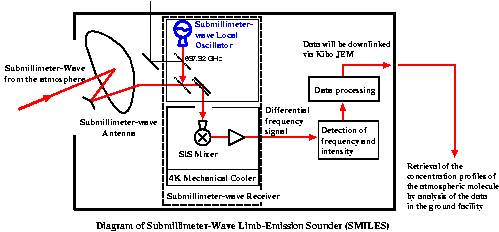Malfunction of a component in the SMILES submillimeter-wave receiver
12th May 2010
The cause of the discontinuance of the SMILES observation at 08:59 of 21th April 2010 (UT) was identified as a failure of a component of the submillimeter-wave receiver. SMILES stands for Superconducting Submillimeter-Wave Limb-Emission Sounder, which is one of the experiment payload on the Exposed Facility of the Kibo Japanese Experiment Module. The investigation of the cause of this failure is continued.
SMILES, that was developed cooperatively by National Institute of Information and Communications Technology (NICT) and Japan Aerospace Exploration Agency (JAXA), is a sensor using a new technology of the spaceborne superconducting (SIS) mixer for observation of the stratospheric ozone and ozone-related minor constituents with the highest sensitivity in the ever existing satellite sensors. The weak submillimeter-wave signal emitted from the Earth's atmosphere is concentrated by the submillimeter-wave antenna and fed to the SMILES receiver.
Submillimeter-wave Local Oscillator, whose expense and management of the development are allotted to the NICT responsibility, is a component of the SMILES submillimeter-wave receiver. The Submillimeter-wave Local Oscillator generates a submillimeter-wave frequency standard, with which the submillimeter-wave signal from the atmosphere is converted into the differential frequency signal. The concentration profile of the atmospheric molecules can be retrieved from this signal.
The Submillimeter-wave Local Oscillator, which had been the stand-by mode since 21st April, was powered on 22nd and 29th April. The telemetry from the Submillimeter-wave Local Oscillator showed that one of the currents in the oscillator exceeded the specified range. Detailed analysis of the telemetry and investigation of the cause of this failure are in progress.
Link :
http://smiles.tksc.jaxa.jp/indexe.shtml
(JAXA SMILES Page)
http://smiles.nict.go.jp/
(NICT SMILES Page)
<Contact>
Public Affairs Department
Tokyo Office
Marunouchi Kitaguchi Building,
1-6-5 Marunouchi, Chiyoda-ku,
Tokyo 100-8260
Tel. +81-50-3362-4374
Fax. +81-3-6266-6911
4-2-1 Nukuikitamachi, Koganei,
Tokyo 184-8795
<As for public relations>
Public Relations Office
Strategic Planning Department
Tel: +81-42-327-6923
Fax: +81-42-327-7587
<As for technical relations>
Y. Murayama, S. Ochiai, or K. Mizutani
Environment Sensing and Network Group
Applied Electromagnetic Research Center
Tel: +81-42-327-6685/6901/6955
Fax: +81-42-327-6678

